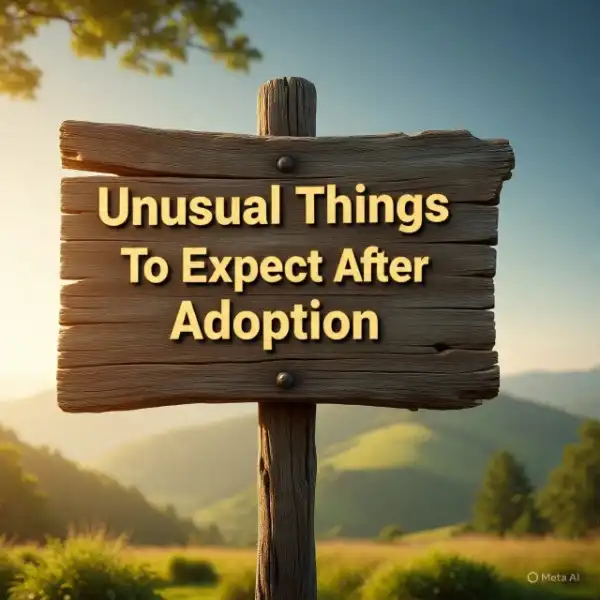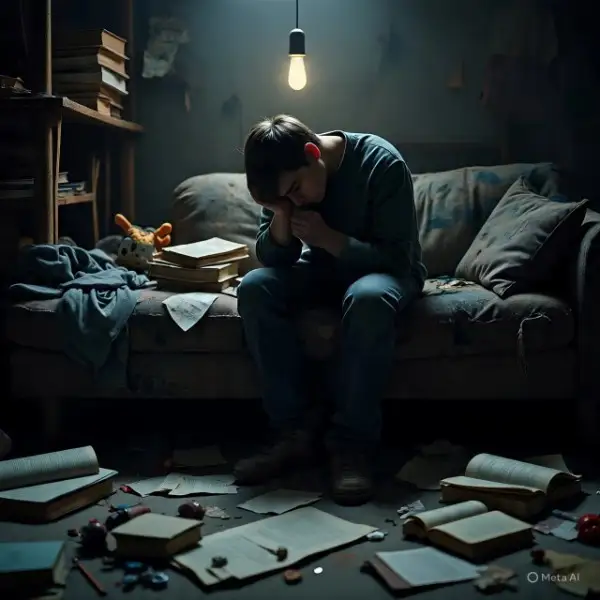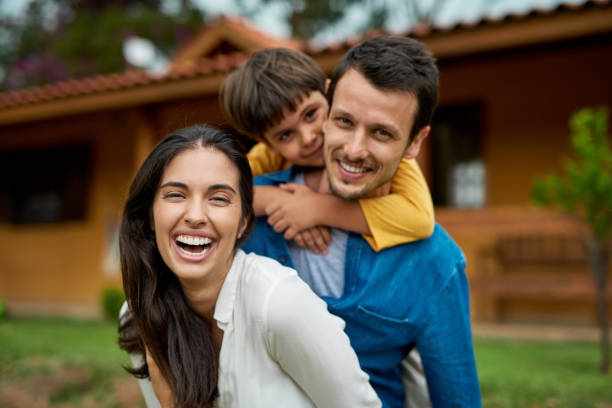After Adoption: 7 Unusual Things To See After Adoption

After waiting, hoping, and praying, you finally got to hold your baby in your arms. Your love, hope, and relief filled your heart, along with a whisper of doubt. The first moment that your child’s heart beats next to yours is not only the story of “after adoption, ” but also the voyage into unknown lands.
I hope these unusual things to expect after adoption do not scare you. Instead, it can be seen as a compass, a help guide that enables you to foresee the unanticipated and react with understanding, strength, and sagacity.
Think of the next five years: you reminisce about the times when you and your child braved the tempest together, how trust got established, how identity matured, and how the story of your family, different, disordered, loving, became a witness of fortitude.
That is the image I want to give you right now. The post-adoption road is rarely straightforward, and most of the time it has unexpected turns. However, with insight, support, and readiness, you will be able to walk it in a dignified manner.
We talk here about the nine rare post-adoption scenarios, which people barely disclose, revealing real examples and templates, and empowering you to react accordingly. By the time you get to the end of the article, apart from feeling more equipped, you will also feel more optimistic.
Emotional Aftershocks You Didn’t See Coming: Attachment Surges and Setbacks:
Right after placement, it may seem that the child will “just bond” with you without any problems. However, you might witness bursts of closeness, very fast trust, immediately followed by freezing, crying, or distancing of the child. These are the emotional aftershocks showing the separation, loss, and trauma experienced by the child.
A typical adoption manual advises new parents that “although you still do not understand his bedtime songs, you find solace in the tone of his voice.” (childrenswi.org) This quote illustrates well the sides of the same coin: sometimes you feel closeness, whilst at others the child seems to shut you out. Be prepared for this.
Don’t lose your head when your child, after a day of closeness, decides to distance himself. That withdrawal is not rejection but defense, a child’s way of shielding from vulnerability.
1) Regression as Progress (Yes, Really):
A toddler starts to need more attention. A child who has been sleeping through the night suddenly wakes up at night. A pre-teen who has been able to do the household chores by himself suddenly asks for help again.
These regressions, refusing to eat, asking for a bottle, speaking in baby language, mostly make one feel irritated. Yet, they are also an indication that the child says, “I need help to feel secure.” Regressive behavior can be a sign of attachment in progress, a child’s adjustment as he/she tests new limits and gets accustomed to “normal” again.
In the adoption world, this is recognized: initial bonding may require going backward before moving forward. One practitioner put it this way: “Allow the toddler or child to regress … Let your child see you as the secure person who is gently fulfilling her needs. (childrenswi.org).
Recognizing regressions as relationship signals (not as disobedience) is one of the handful of surprising things a person can expect after adoption, which most people are caught unawares by this fact.

2) Hidden Grief and Loss Beneath the Surface:
Adoption is a new chance, but it does not mean that the past can disappear or that the past was safe. One of the most surprising things to expect after adoption is that grief will appear in the most unexpected places.
3) The Quiet Tears, the Secret Questions:
Your child may come to you months after the placement and ask questions such as “Why was I given away?” or “Who is my birth mom?” You may look away, not having any idea of what to say. However, grief is not always extreme.
It manifests itself in wistful silence, suddenly bursting into tears while doing the laundry, or a meltdown at bedtime.
Even now, adult adoptees talk about grief that “comes in waves” at anniversaries, graduation ceremonies, or milestones. (All For Kids) Your kid may not be able to recognize his/her emotional state; nevertheless, grief is tangible. Always be prepared.
From the adoptee literature, the “loss, rejection, identity, shame, intimacy, mastery” schema is standard: a great number of kids experience guilt, confusion, longing, after adoption, etc. (All For Kids). Being aware of this in advance gives you lots of patience when a birthday or a biological milestone agitates the child.
Grief in Parents: Post-Adoption Depression:
It is not only the children who suffer. Some parents who have adopted children find themselves grieving, mourning the loss of infertility, the end of the expected, or even getting emotionally exhausted with the process of adopting.
A term, parental post-adoption depression (PAD), is used to describe this incidence. Different studies have reported a range in prevalence from 8 % up to 32 % in different samples; however, the latest research indicates that about 11–12 % of parents can exhibit depressive symptoms at a clinically significant level. (National Council For Adoption)
Being joyful is what parents mostly anticipate, and then they experience this feeling of subtle emptiness, which is one of the weirdest things you can expect after an adoption, and many people are shocked by it. It is important that you acknowledge it, find your support, and allow yourself to grieve as a part of your transition.
2) Intense Identity Development and Questions of Belonging:
After children become part of the family, the hidden identity struggle might start, and sometimes a child may even erupt with it.
3) Who Am I Now? The Search for Identity:
Adopted kids in general have dual identities: one related to their biological heritage and the other one related to their adoptive family. When it comes to adoption in different countries, a child may find it difficult to combine and identify with both cultures.
Transracial placement may similarly pose a problem to the child, as in this case, the racial identity might become vivid as the child grows. Children may also find themselves questioning their place in the family. They may wonder if they belong to their biological family or the new one. Why was I adopted?
Children in the process of finding their identities may become more vocal about it when they reach puberty; however, they can also exhibit signs even at a younger age: they might ask for medical history, get suddenly fascinated with the birth culture, or express dissatisfaction with their appearance (e.g., skin color).
As adoptive parents, you are not the ones to manage the storyline but rather be the ones to create a safe environment – safety, curiosity, openness to sharing, and affirmation.
The Minnesota/Texas Adoption Research Project (MTARP) found that the level of openness in adoptive families (adoption-related communication, birth-family contact if available) often corresponded with more positive identity outcomes.
(Wikipedia) One of the less obvious and more subtle unusual things to expect after adoption is the decision to promote truth and curiosity rather than hiding away birth heritage.

4) Identity Crises That Don’t Fit the Calendar:
Your child can experience a crisis not at the “right age” but rather at the time of middle childhood or early adolescence. They might even say: “I do not want to be your child anymore,” or ask: “Maybe I belong with someone else.”
These are frightening concepts, but often part of maturing. Your work is to be emotionally stable, acknowledge their sorrow, and keep the conversation going. The transition from “belonging by default” to “belonging by choice” is a difficult yet transformative phase.
5) Behavioral Surprises: The Hidden Aftershocks of Trauma:
One of the most distressing, unusual things to expect after adoption is behavioral inconsistency, which is quite difficult to reveal even when the child was “well-behaved” in writing.
Unexpected Triggers and Meltdowns:
Emotion overload may be triggered by such things as a loudly slamming door, a certain smell, a sibling’s tone, or even a song. In some instances, a child can turn from being calm to violent in a very short time or unexpectedly isolate themselves in silence.
These are not simple issues of discipline. They could be the remnants of trauma, attachment, inability to regulate, or relational stress.
The research made by the Queensland Foster Care and Adoption Network FA5 has shown the behavioral and emotional difficulties that come with children who had been adopted from foster care: 58 % of them needed specialized health care, 68 % had educational delays, 69 % exhibited conduct issues, and 83 % showed serious emotional or behavioral difficulties.
(Families Rising) There is, in fact, evidence presented in one research that about 40 % of welfare-adopted children end up scoring in the clinical range years after adoption. (Families Rising).
Discrepancy Between Chronological Age and Emotional Age:
Your 8-year-old child may under pressure behave like a 4-year-old. Your teenage son or daughter might require assistance in managing their frustration.
The emotional age lag issue is quite common, and most of the time, it is invisible until there is a conflict. As a warning from an adoption manual: “Your child’s emotional age can be very much younger than the chronological one.” (childrenswi.org)
After adoption, you should be ready to adjust your expectations. Calmness, consistency, providing support for emotion regulation, and trauma-aware disciplining will be much more effective than the usual practice of giving rewards/punishments.
Surprising Social and Peer Challenges:
As your kid becomes comfortable, the social aspect may still cause problems that you had not thought of–one of the most subtle social challenges after adoption.
Peers, Bullying, and Disclosure:
At school, kids might come with questions: “Why are you not looking like your parents?”, “Where is your real mom?”. Some adoptees even refuse the word “real”. These peer inquiries seem to be very personal for your child.
You may find it helpful to practice role-playing with your child, or have a simple answer like “We’re all a bit different” ready. Also, have teacher, classmate, and caregiver “cheat sheets” so your child doesn’t feel like he/she is put under the spotlight.
The fear of being labeled “that adopted kid” is the one that most tightly grasps the children who are adopted—they can feel lonely. You may witness them avoiding social events or hiding their adoption status. Understand this as their way of protection, not shame.
Extended Family and Community Acceptance:
Your extended family members may, unintentionally, make you feel uncomfortable, talking about “real family,” comparing, or making insensitive comments. Neighbors or religious groups might also be very curious and ask you questions that you may find intrusive.
This might lead to a feeling of being stuck in a circle and forcing you into the role of an advocate. Among the unusual things to expect after adoption is the necessity to educate your community.
Get ready with polite but firm answers: “We are happy to be questioned, but we prefer to choose the time for answering personal questions about adoption.”
Eventually, the kid may become the face of adoption, and his/her role will be to promote it. Although some mature adoptees might be glad to take on this role, children may be reluctant. Support them, don’t lead them.
Post-Adoption Instability: A Hidden Risk You Must Know:
In most of the conversations about adoption, the word permanence is the one mostly emphasized. One of the most startling, unusual things to expect after adoption is the risk of post-adoption instability, whether formal or informal.
How Common Is Instability After Adoption?
A landmark study commissioned by ACF found that about one-third of the children adopted from foster care experienced formal or informal instability. Some of them had to return to foster care (10 %), while some left the home in their youth (30 %) through running away or living in another place.
(Voice for Adoption) Initially, the estimation of the cumulative events was between 5 and 20 %, but this broader design revealed hidden instability, such as going away from home before reaching adulthood. (Voice for Adoption)
Additionally, nearly 10 % of adoptees in other samples had to face post-adoption disruption or reentry into care. (Administration for Children and Families).
The figures thus stress the importance of post-adoption support, which should not be considered as an option only. The demonstration of permanence has to be accompanied by humility, support, and continuous care.
Predictors, Warning Signs, and Prophylactic Measures:
The factors that increase the risk are the age of the child at adoption, being older, the child’s behavioral problems at an early age, weak closeness between parent and child, having unrealistic expectations, and insufficient post-adoption services. (Voice for Adoption)
To prevent the situation of instability:
- It is best to start a therapeutic relationship to provide support. (behavior, attachment, trauma).
- Choose to talk openly and not keep things to yourself.
- Always be ready for family therapy with a low threshold.
- Develop a safety network consisting of support: relief, mentors, and community.
- It is better not to be in a “wait and see” situation, but get help at the earliest possible time.
One of the unusual things to expect after adoption is the necessity of being vigilant all the time, not because you are skeptical of your family, but because the heritage of loss and trauma is still there, even if placement is final.
Evolving Parental Identity and the Hidden Weight of Responsibility:
You are not the same person you were before the adoption. How deeply your identity changes and how heavy the feeling of responsibility becomes is one of the richest but mostly unspoken, unusual things to expect after adoption.
The Pressure of “Doing It Right”
Adoptive parents are usually overwhelmed with the idea that they have to “make it all okay,” that they have to heal all the wounds, and that they have to provide perfect love.
The enormous burden can make the parents very watchful, feeling guilty, getting exhausted, or irritated without expressing a word. After the adoption is complete and the adrenaline level goes down, some people feel that “post-party let-down.” (Postpartum Support International (PSI))
Without realizing it, you could be checking your kid’s every mood, reading every professional article, and questioning every decision. This watchfulness comes from love, but it should be combined with self-grace and limits.
Integration of A New Normal:
After several months or years, your identity will be different. Your life before adoption seems like a thing of the past. Your life now revolves around the crises, appointments, therapy sessions, and school changes.
One of the reasons couples get into conflict is that one partner internalizes the burden in a different way than the other. The research on parental post-adoption depression shows that emotional and expectation overload are factors that are strongly correlated with symptomatology. (PMC).
One expert suggests changing the focus of expectations: instead of “I have to heal this child,” take the position “I will support my child during the healing process.” (Foster Adopt Minnesota).
| No. | Unusual Thing. | What You Might See. | Suggested Parental Response. |
| 1 | Attachment surges & setbacks | Closeness, then withdrawal | Hold steady, expect flux, meet closeness gently |
| 2 | Hidden grief & emotional surfacing | Tears, questions, secret sadness | Validate emotions, provide opportunity to share. |
| 3 | Intense identity development. | Questions of belonging, heritage searching. | Encourage safe exploration, affirm identity. |
| 4 | Behavioral surprises. | Meltdowns, regressions, triggers. | Trauma-informed approaches, emotional scaffolding. |
| 5 | Social & community challenges. | Peer questions, insensitive remarks. | Educate circle, equip your child, protect dignity. |
| 6 | Post-adoption instability. | Elopement, reentry, family conflict. | Invest in support early, stay vigilant. |
| 7 | Shifting parental identity. | Burnout, pressure, internal conflict. | Self-care, boundaries, realistic expectations. |
| 8 | (to be continued…) | – | – |
| 9 | (to be continued…) | – | – |
(Later, you can extend the table to include points 8 and 9 when you finalize.)
Progress That’s Quite Slow and Sometimes Uneven:

One of the less talked about unusual things to expect after adoption is how progress can be quite slow, uneven, and non-linearly in most cases. Maybe you expect a gradual improvement – “every month will be better than the previous one.” However, the truth is often very different.
Small Wins: Recognize What Doesn’t Look Like Big Change:
Maybe your kid sleeping through the night one more night, asking a simple question about adoption, making eye contact, tolerating that you stand close for five more seconds – these might be huge.
But you could also feel frustrated with the fact that the big breakthrough you had in mind has not come yet. A therapist once said, “Your kid won’t get out of chronic trauma in 30 days. Don’t expect a spectacle; expect baby steps.”
Celebrate incremental wins. Use a simple chart:
| Date. | Behavior Shift. | Parental Reflection |
| March 1 | Took the initiative to ask about birth | I felt proud and softly replied with my story |
| April 5 | Tolerated sibling cuddle | I sat quietly beside and said nothing, just stayed present |
| May 10 | Spoke negatively about self, paused | I asked, “Tell me more,” and held space. |
This manner of recording development lets you observe progress over a certain period and fight the “nothing is happening” mentality.
When Time Feels Stuck:
Some months may seem as if nothing is going on, you may be especially hard on a character of difficult seasons (puberty, academic stress, loss anniversaries). You might even be doubting the way you took. That’s a perfectly normal thing to do.
One of the unusual things to expect after adoption is that you still have enough emotional energy during that state of stasis. In those moments, you might want to rely on the people who support you, go over your family values once again, and remember: the roots keep growing even though the shoots might not be visible yet.
The Desire of Support Perpetually: Adoption Is Not Over When Finalization Comes:
Lastly, the most important, though least talked about, unusual things to expect after adoption is that your need for assistance will go on forever. Adoption is a forever thing, and so is the process of learning.
Post-Adoption Services and Their Underuse:
According to a comprehensive report, post-adoption services such as counseling, therapeutic support, parent training, respite, etc., are not accessed by people uniformly. Support is not sufficient for many adoptive families. (aspe.hhs.gov)
However, those families who decide to avail themselves of the services are in a better position to overcome the crises. For instance, the study on instability shows that 75% of those families that experienced instability also got services (albeit maybe later). (Voice for Adoption) Being proactive is definitely better than being in a reactive situation.
Lifelong, Flexible, Tiered Support:
The growth of your kid will present you with different issues, changing schools, reaffirming identity, getting through adolescence, dating, and becoming an adult.
You may concurrently avail yourself of several types of assistance, such as individual therapy, family therapy, adoption-specific peer groups, life story work, mentoring, and education consults. Use a “needs audit” concept every year:
- What issues arose this year?
- What support did we take advantage of?
- Which gaps still exist?
- What new support will we need next year?
The audit here serves as the crisis prevention roadmap for intervention. Be prepared to seek help not only during your first year but also in your fifth, tenth, and subsequent years.
Practical Example / Template: “Adoption Integration Check-In” Document:
Below is a simple template you can use annually or semi-annually to guide your family through reflection, recalibration, and intention. Adapt it to your context.
[Your Family’s Adoption Integration Check-In | Date:
- Wins & Progress: Think of three changes (either of a child or family) that you have noticed since the last time we met. Which one of those changes has the biggest impact on you?
- Struggles & Pain Points: Remember the two most frequent challenges (for example, meltdown, identity questions, and school) that have been coming up in your life. How did you react to them? What kind of patterns do you notice?
- Emotional Climate: Rate closeness, conflict, intimacy, and safety in your household on a scale from 1 to 10. What factors lead to these levels? What are the things that break them down?
- Support Inventory: Write down the current supports you receive from professionals, therapists, peer supports, respite, and resources. Which of these supports have been the most helpful to you? Which of them is not enough?
- Goals for Next Period: Point out 2–3 achievable goals (for example, try a new therapy, open a conversation about identity, join a support group). Make small, manageable steps to achieve (for example, look up information, make a schedule, invite your child to give his/her opinion).
- Self-Care Commitment (Parents): Jot down one thing that you will do each month for your emotional renewal. Write down one boundary that you will maintain (for example, no crisis calls after 9 pm, weekly check-in with spouse).
- Communication Step: Prepare a short family conversation (for example, “Let everybody name one thing that was hard and one thing that was good this year”). Think of ways to get your child’s perspective (talk, drawing, letter, journal).
It would be helpful to keep these in a binder or digital folder, to look at them each year, and to compare them over the years. Eventually, you can clearly see your progress even if there are still storms going on outside.
The Journey of “Amara” and Her Parents:
The arrival of Amara, a 7-year-old, at the house of Sarah and Michael was met with the expectation that love and routine would quickly be established. Yet, Amara kept having bad dreams; she did not eat the food offered to her, and she would often lock herself in a closet, crying for “home.” Sarah thought, I really didn’t expect this.
After just one month, Amara queried, “Did you love me more than my mom?” Sarah was stumped in her reaction. They engaged in family therapy, and the therapist coached them to acknowledge feelings without necessarily answering: “I love you, and I hear your question.”
Over time, Amara’s nightmares became less frequent; however, on a Thanksgiving evening, she yelled, “I want my old life.” It was day 237.
In school, a friend of Amara’s called out, “Are you from the orphanage?” Amara was at a loss for words. Sarah had already prepared her with a straightforward response: “We became one family. Some kids come from different places.” Amara mumbled it.
At the age of 14, Amara, after deep reflection, felt that she was more connected to her birth country’s culture, and consequently, she sought assistance in tracing her heritage. Sarah and Michael were there for her, helping her put together the story of her life in a scrapbook.
Nothing, whether it be the good or the bad times, changed the fact that they continued to choose her, especially when she doubted them, challenged them, or distanced herself from them.
Before the Once-upon-a-time of After Adoption: 9 Unusual Things To Expect After Adoption, Amara’s voyage embodies the majority, attachment reversals, grief, identity thrusts, therapy seasons, and gradual parental maturation.
Conclusion: Walk With Us Beyond Adoption:
You now have learned most of the things you can see after adoption from this post. For example, you understand that attachment is not a one-time moment. You’re wise to expect grief, identity battles, behavioral surprises, social tension, instability risk, parental shifts, and slow progress.
The best of it all is that you have been handed the tool, perspective, and confirmation that you are on a real, live journey that others have walked. If this is what you wanted to learn, then don’t walk alone.
Here’s what you can do next:
Contact a therapist or consultant who is competent in adoption for a free 20-minute intake; a lot of them provide a sliding scale, or the first consult is free.
Save this post as a favorite, come back to it when your days are difficult, and understand that the unexpectedness does not indicate failure; it signifies that you are going deeper.
If you want a version specific to Nigeria, or a version for international adoption, or children of a certain age, just let me know. We cannot stop walking together. Adoption is not the end at finalization; it is the beginning of deeper love, the facing of challenges, and the becoming of transformation.
Just do it. The check-in sheet is available for download right now, support is within reach if you make that call, and I know you dare to move forward.
FAQs About After Adoption: 9 Unusual Things To Expect After Adoption:
Q1: Should I be worried if my child doesn’t “love me” right away?
No. It is quite common for children to take months or even more time before they show affection. Generally, bonding takes less time in birth bonding than in adoption. This delay is actually one of the little surprises among the unusual things to expect after adoption. Eventually, it is through consistency, safety, and emotional responsiveness that trust is built.
Q2: Is it so that depression after adoption means that I have failed?
Absolutely, no. Parental postadoption depression (PAD) is reported in 11–12 % of the parental population, according to recent studies. (National Council For Adoption) It is quite an expected emotional symptom due to the heavy load of high expectations, fatigue, grief, and relational overload. If you feel down, help yourself: get help, talk it over, and change the way you see your expectations of the situation—failure is not the word here.
Q3: I want to prepare the people around me for the hard times. How?
Use a “FAQ cheat sheet” as a means of communication with those closest to you such as family, friends, teachers. Sample sentence: “Our adoption was through foster care. Our child might ask you some really tough questions. Please listen instead of trying to fix.” Provide them with resources (easy-to-read articles, adoption-competent books) that will make them safe allies, not well-meaning saboteurs.
Q4: Is it strange that I still need therapy years later?
No. One of the unusual things to expect after adoption is that, in some cases, the biggest breakthroughs or crises that happen later, rather than early. Often, therapy later in life can be more effective because the client has more trust and is more aware of their patterns.
Q5: What if my child will reject me when he or she becomes a teenager?
This is quite normal. A lot of adopted teens will challenge authority, reject relationships, or show identity revolt. Do not leave the scene, be strong, do not give in to ultimatums, talk as much as you can. Participate in family therapy, do not use shame to deal with the situation, and get connected again through the values you both share.
Q6: When is it time for me to be concerned about stability or disruption?
It would be a cause for concern if your child, on multiple occasions, tells you that he or she wants to leave, runs away, or insists on the point that adoption is wrong. In addition, if you notice extreme behavior without intervention—then these, along with the aforementioned signs, are the “red flags”. The statistics that 33 % of adoptees may experience events that affect their stability, make early intervention at the signs of distress absolutely necessary. (Voice for Adoption)




